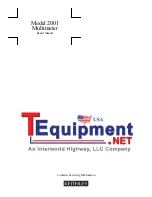
6
Range
Free Cl
2
0.00 to 5.00 mg/L
Total Cl
2
0.00 to 5.00 mg/L
Resolution
0.01 mg/L from 0.00 to 3.50 mg/L; 0.10 mg/L above 3.50 mg/L
Precision
±0.02 mg/L @ 1.00 mg/L
Typical EMC Deviation
±0.01 mg/L
Light Source
Tungsten lamp with narrow band interference filter @ 525 nm
Light Detector
Silicon Photocell
Method
Adaptation of the
USEPA Method 330.5
and
Standard Method
4500-Cl G
. The reaction between chlorine and DPD reagent causes a
pink tint in the sample
LOG Memory
99 records
Serial Interface
RS232 @ 9600 baud rate
Environment
0 to 50°C (32 to 122°F); max 95% RH non-condensing
Power supply
4 x 1.5V AA alkaline batteries
Auto Shut-off
After 10 minutes of non-use in
measurement mode
After 1 hour of non-use in
calibration mode
Dimensions
216 x 83 x 65 mm (8.5 x 3.26 x 2.55”)
Weight
420 g (17 oz.)
REQUIRED REAGENTS
Code
Unit
Description
Quantity/test
HI 93701-0
Free Cl
2
Free Chlorine Reagent
1 packet
HI 93711-0
Total Cl
2
Total Chlorine Reagent
1 packet
SPECIFICATIONS
SPECIFICATIONS
SPECIFICATIONS
SPECIFICATIONS
SPECIFICATIONS
Precision
is how closely repeated measurements
agree with each other. Precision is usually
expressed as standard deviation (SD).
Accuracy
is defined as the nearness of a test
result to the true value.
Although good precision suggests good accuracy,
precise results can be inaccurate. The figure
explains these definitions. In a laboratory using
a standard solution of 1.00 mg/L chlorine and a
representative lot of reagent, an operator obtained
with a single instrument a standard deviation
of 0.02 mg/L.
PRECISION AND ACCURACY
PRECISION AND ACCURACY
PRECISION AND ACCURACY
PRECISION AND ACCURACY
PRECISION AND ACCURACY







































